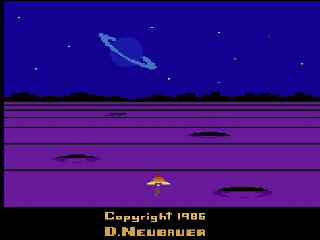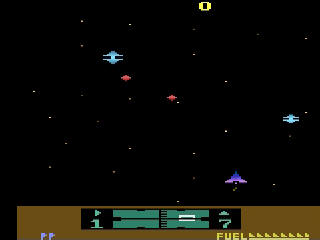 Considered by many to be the best-looking game ever released for the Atari 2600, Solaris is a complex and challenging game that offers hours of gameplay.
Considered by many to be the best-looking game ever released for the Atari 2600, Solaris is a complex and challenging game that offers hours of gameplay.
Developed by Doug Neubauer, Solaris was originally slated to be released in 1984 as The Last Starfighter, based on the movie of the same title. However, Warner Communications sold Atari’s consumer division that same year and the game was shelved for a couple of years. Fast-forward to 1986. Jack Tramiel has realized that there could still be some money to be milked out of the Atari 2600, and Atari Corp. released its redesigned 2600 console, now called the 2600 Jr., alongside the Atari 7800. A few new games were also released for the 2600, including The Last Starfighter, now re-titled Solaris and sold as a sequel to Star Raiders (also created by Neubauer).
Solaris is composed of 4 different game screens: the space travel screen, the galaxy scanner, the warp corridor and the planet surface (either a Zylon planet, populated by enemy Zylons, or a friendly Federation planet).
The purpose of the game is to find the planet Solaris before the Zylons destroy it, and rescue the Atarian Federation pioneers stranded on it. This can be achieved by navigating through 16 quadrants, composed of 48 sectors each. Sectors can be occupied by enemies (which can move within the quadrant), or by a planet, a wormhole or a corridor. There are also star clusters, which do nothing but block the way between some sectors. Wormholes allow you to jump beyond a star cluster within the same quadrant, while corridors block the way to another quadrant (each side of a quadrant also has a door leading to another one). Needless to say, map-making is a must if you want to find your way with all these quadrants!
 Each quadrant features one Federation planet, which you must protect from Zylons. This planet allows you to fill up your ship’s fuel and repair any damage sustained by the ship, via a docking bay. If Zylons succeed in blowing up the Federation planet (which you too can blow up if you shoot at the planet’s docking bay), mayhem occurs. Space
traveling then becomes difficult: the screen turns red (instead of the usual space black), the controls are reversed and a maddening, constant noise blasts off your TV. And you’re out of docking bays for that quadrant!
Each quadrant features one Federation planet, which you must protect from Zylons. This planet allows you to fill up your ship’s fuel and repair any damage sustained by the ship, via a docking bay. If Zylons succeed in blowing up the Federation planet (which you too can blow up if you shoot at the planet’s docking bay), mayhem occurs. Space
traveling then becomes difficult: the screen turns red (instead of the usual space black), the controls are reversed and a maddening, constant noise blasts off your TV. And you’re out of docking bays for that quadrant!
On the other hand, Zylon planets (shaped like Saturn on the scanner), are a blast. If you rescue all the Federation cadets on a same Zylon planet, it explodes and gives you an extra life.
The design of the Zylons is varied, from the vicious Cobra Ships (which resemble green skulls) to the pink, crab-shaped Mechnoids (as well as many others). You face these enemies in space or on planets, but they are also found in corridors. Bumping into Zylons has different consequences on your ship, depending on the type of enemy. Cobra Ships are deadly: one contact and you lose a precious ship. Blockaders are not nearly as dangerous, but bumping into them can make you lose some fuel and/or damage your targeting computer (which is very useful to locate enemies in space, or docking bays on Federation planets).
Visually, the game is simply gorgeous, especially when flying over a planet surface (which has a nice 3D effect to it with a rich color scheme). The planets/asteroids that fly by as you navigate in space are reminiscent of the 2600 port of Asteroids (incidentally, you can shoot them in Solaris, but the sole purpose of doing so is to keep them from bumping into your ship). The enemies are also well-defined and colorful, which makes it easy to tell a Cobra Ship apart from, say, a Mechnoid. The game has a title screen, which is basically a screenshot from the planet surface with the indication “Copyright 1986 D. Neubauer” (a far cry from the “keep all Atari programmers anonymous” policy of the early days!). When looking at Solaris, it is difficult to believe that this is a 2600 game instead of a 7800 game!
 The game is devoid of music, save for the warning tune alerting you when a Federation planet is under attack. However, sound effects are provided throughout the game, including when shooting or bumping into Zylons and picking up cadets, so you know what’s going on at all times. Since the 2600 was never known for its extensive use of music, no one will be disappointed to learn that the game doesn’t feature a real soundtrack.
The game is devoid of music, save for the warning tune alerting you when a Federation planet is under attack. However, sound effects are provided throughout the game, including when shooting or bumping into Zylons and picking up cadets, so you know what’s going on at all times. Since the 2600 was never known for its extensive use of music, no one will be disappointed to learn that the game doesn’t feature a real soundtrack.
Unlike Star Raiders, Solaris does not require a keypad controller. Instead, the scanner (which is used to navigate through quadrants) can be quickly accessed by pressing the fire button on a second plugged joystick (this is optional; the scanner will appear even if you’re using only one joystick, but it will come on more slowly). Otherwise, the ship is directed with the joystick (pulling the stick down will slow down the ship without stopping it entirely), while the fire button is used to shoot at enemies. Remember: letting a Federation planet blow up turns the quadrant into a red zone with reversed controls!
Atari’s packaging of the game is at the same time satisfying and disappointing. The box is nicely full-colored, as it’s part of the burgundy series of 2600 releases, but the label is a black and white version of the box art, and the manual is monochrome (the only color being a pinkish shade of red).
All in all, Neubauer took his Star Raiders game and fine-tuned its main elements into a deep game that requires as much strategy as it needs good reflexes. It can sometimes be frustrating to go through the maze of quadrants, but it makes the game as challenging as a puzzle, while retaining the qualities of an action game. For people who can’t find the planet Solaris despite their best efforts (and map-making), a walkthrough, including screenshots of all the quadrants, exists online at http://members.tripod.com/skintigh/atari/solaris.html.
